spare tire VOLVO XC90 2009 Owner´s Manual
[x] Cancel search | Manufacturer: VOLVO, Model Year: 2009, Model line: XC90, Model: VOLVO XC90 2009Pages: 282, PDF Size: 8.76 MB
Page 6 of 282
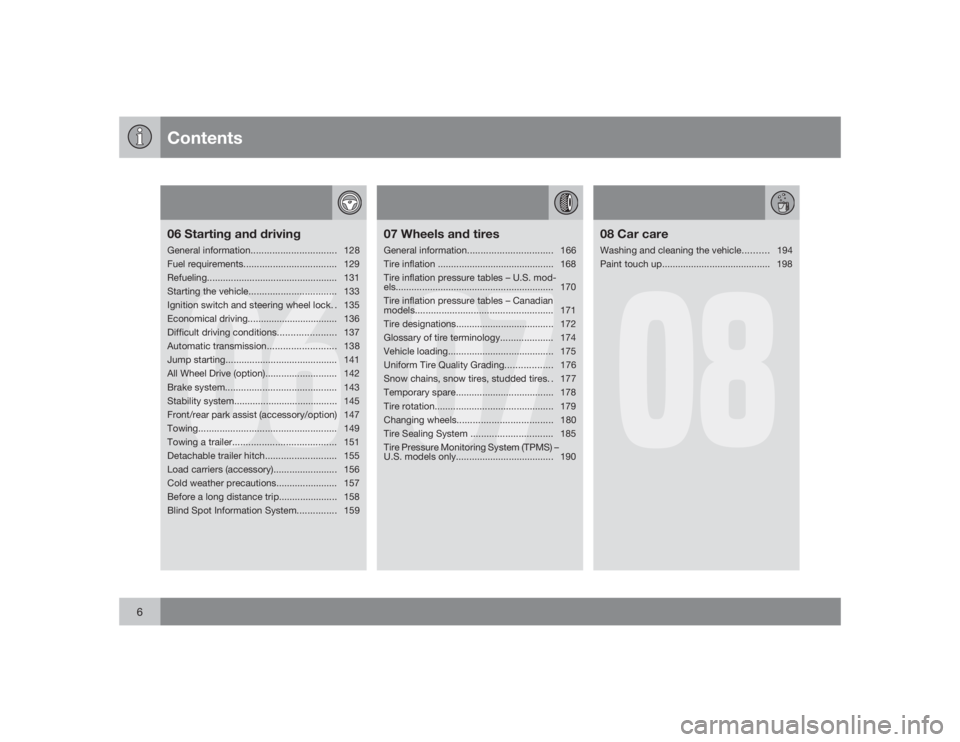
Contents
6
06
06 Starting and drivingGeneral information................................128
Fuel requirements................................... 129
Refueling................................................. 131
Starting the vehicle................................. 133
Ignition switch and steering wheel lock. . 135
Economical driving.................................. 136
Difficult driving conditions...................... 137
Automatic transmission..........................138
Jump starting.......................................... 141
All Wheel Drive (option)........................... 142
Brake system.......................................... 143
Stability system....................................... 145
Front/rear park assist (accessory/option) 147
Towing.................................................... 149
Towing a trailer....................................... 151
Detachable trailer hitch........................... 155
Load carriers (accessory)........................ 156
Cold weather precautions....................... 157
Before a long distance trip...................... 158
Blind Spot Information System...............159
07
07 Wheels and tiresGeneral information................................166
Tire inflation ............................................ 168
Tire inflation pressure tables – U.S. mod-
els............................................................ 170
Tire inflation pressure tables – Canadian
models.................................................... 171
Tire designations..................................... 172
Glossary of tire terminology.................... 174
Vehicle loading........................................ 175
Uniform Tire Quality Grading.................. 176
Snow chains, snow tires, studded tires. . 177
Temporary spare..................................... 178
Tire rotation............................................. 179
Changing wheels....................................180
Tire Sealing System ............................... 185
Tire Pressure Monitoring System (TPMS) –
U.S. models only..................................... 190
08
08 Car careWashing and cleaning the vehicle.......... 194
Paint touch up......................................... 198
Page 142 of 282
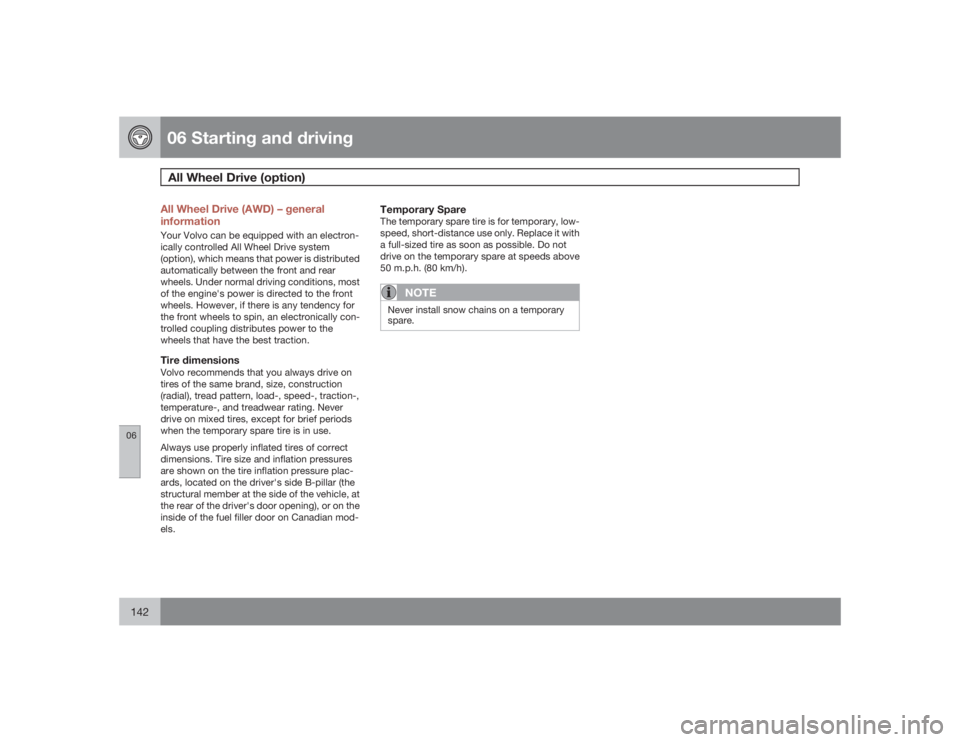
06 Starting and drivingAll Wheel Drive (option)
06142
All Wheel Drive (AWD) – general
informationYour Volvo can be equipped with an electron-
ically controlled All Wheel Drive system
(option), which means that power is distributed
automatically between the front and rear
wheels. Under normal driving conditions, most
of the engine's power is directed to the front
wheels. However, if there is any tendency for
the front wheels to spin, an electronically con-
trolled coupling distributes power to the
wheels that have the best traction.Tire dimensionsVolvo recommends that you always drive on
tires of the same brand, size, construction
(radial), tread pattern, load-, speed-, traction-,
temperature-, and treadwear rating. Never
drive on mixed tires, except for brief periods
when the temporary spare tire is in use.
Always use properly inflated tires of correct
dimensions. Tire size and inflation pressures
are shown on the tire inflation pressure plac-
ards, located on the driver's side B-pillar (the
structural member at the side of the vehicle, at
the rear of the driver's door opening), or on the
inside of the fuel filler door on Canadian mod-
els.
Temporary SpareThe temporary spare tire is for temporary, low-
speed, short-distance use only. Replace it with
a full-sized tire as soon as possible. Do not
drive on the temporary spare at speeds above
50 m.p.h. (80 km/h).
NOTE
Never install snow chains on a temporary
spare.
Page 158 of 282
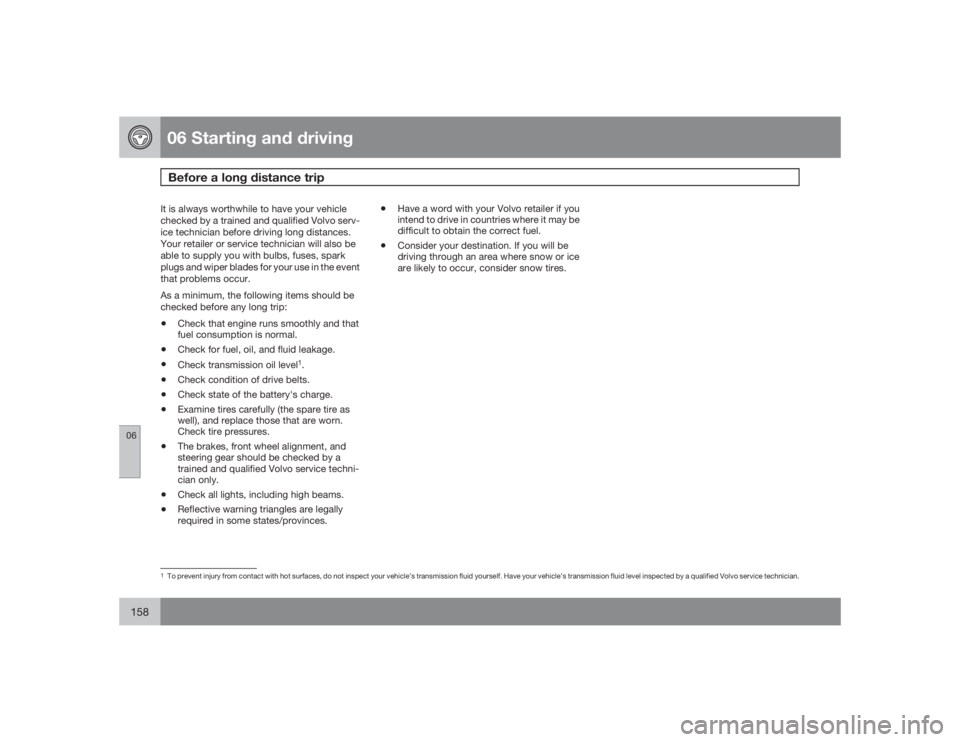
06 Starting and drivingBefore a long distance trip
06158
It is always worthwhile to have your vehicle
checked by a trained and qualified Volvo serv-
ice technician before driving long distances.
Your retailer or service technician will also be
able to supply you with bulbs, fuses, spark
plugs and wiper blades for your use in the event
that problems occur.
As a minimum, the following items should be
checked before any long trip:•
Check that engine runs smoothly and that
fuel consumption is normal.
•
Check for fuel, oil, and fluid leakage.
•
Check transmission oil level
1.
•
Check condition of drive belts.
•
Check state of the battery's charge.
•
Examine tires carefully (the spare tire as
well), and replace those that are worn.
Check tire pressures.
•
The brakes, front wheel alignment, and
steering gear should be checked by a
trained and qualified Volvo service techni-
cian only.
•
Check all lights, including high beams.
•
Reflective warning triangles are legally
required in some states/provinces.
•
Have a word with your Volvo retailer if you
intend to drive in countries where it may be
difficult to obtain the correct fuel.
•
Consider your destination. If you will be
driving through an area where snow or ice
are likely to occur, consider snow tires.
1To prevent injury from contact with hot surfaces, do not inspect your vehicle’s transmission fluid yourself. Have your vehicle’s transmission fluid level inspected by a qualified Volvo service technician.
Page 164 of 282
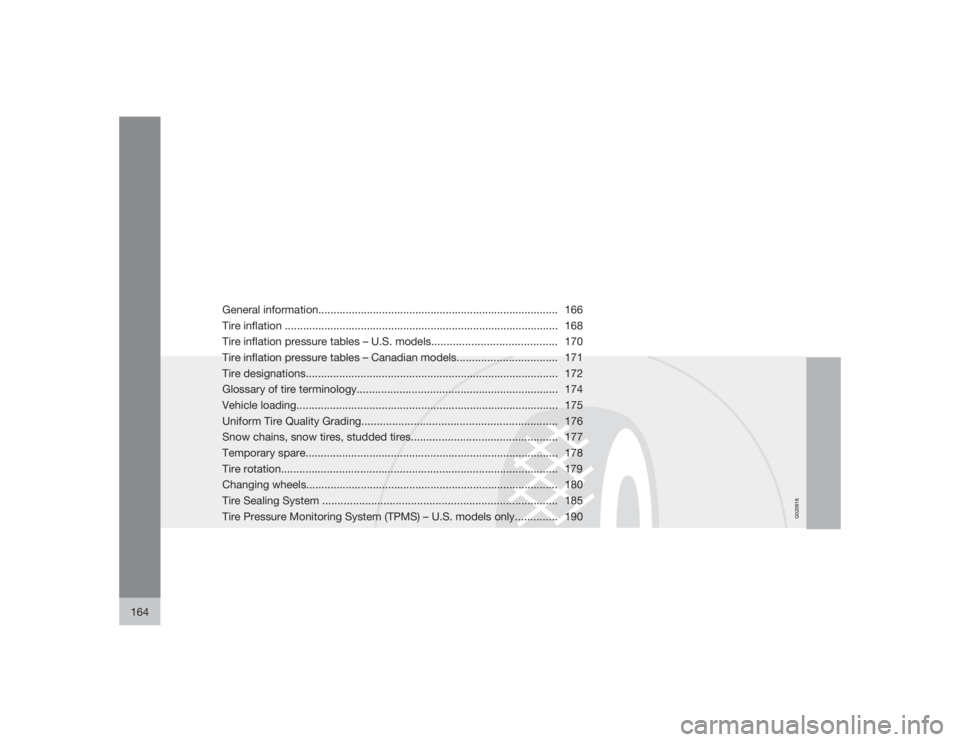
G020918
164
General information............................................................................... 166
Tire inflation .......................................................................................... 168
Tire inflation pressure tables – U.S. models......................................... 170
Tire inflation pressure tables – Canadian models................................. 171
Tire designations................................................................................... 172
Glossary of tire terminology.................................................................. 174
Vehicle loading...................................................................................... 175
Uniform Tire Quality Grading................................................................ 176
Snow chains, snow tires, studded tires................................................ 177
Temporary spare................................................................................... 178
Tire rotation........................................................................................... 179
Changing wheels................................................................................... 180
Tire Sealing System ............................................................................. 185
Tire Pressure Monitoring System (TPMS) – U.S. models only.............. 190
Page 167 of 282
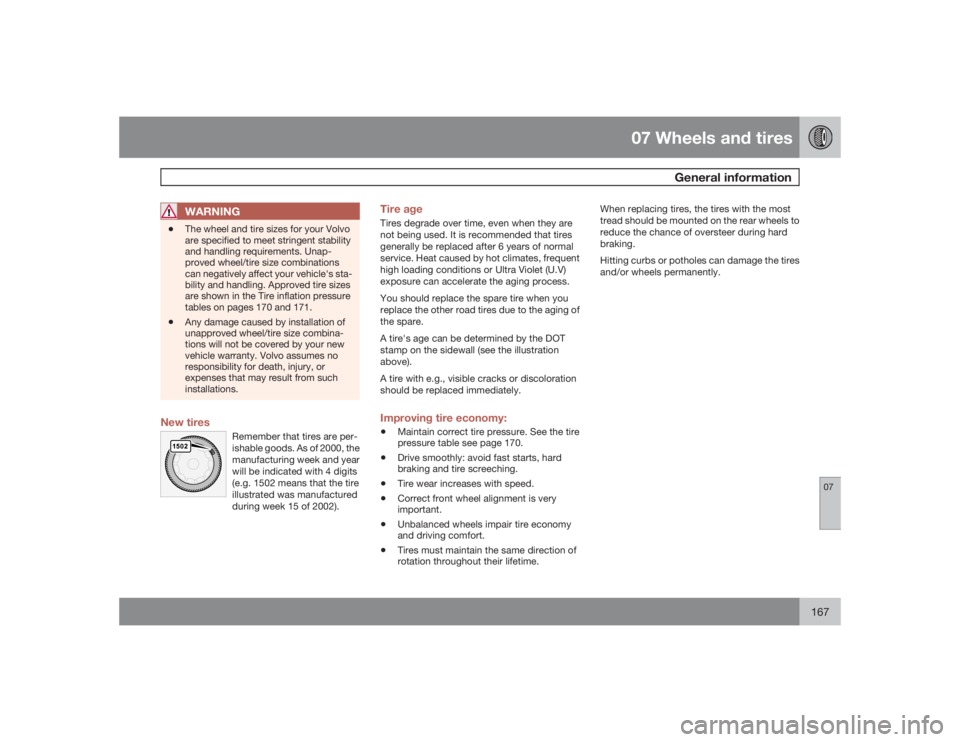
07 Wheels and tires
General information
07
167
WARNING
•
The wheel and tire sizes for your Volvo
are specified to meet stringent stability
and handling requirements. Unap-
proved wheel/tire size combinations
can negatively affect your vehicle's sta-
bility and handling. Approved tire sizes
are shown in the Tire inflation pressure
tables on pages 170 and 171.
•
Any damage caused by installation of
unapproved wheel/tire size combina-
tions will not be covered by your new
vehicle warranty. Volvo assumes no
responsibility for death, injury, or
expenses that may result from such
installations.
New tires
Remember that tires are per-
ishable goods. As of 2000, the
manufacturing week and year
will be indicated with 4 digits
(e.g. 1502 means that the tire
illustrated was manufactured
during week 15 of 2002).
Tire ageTires degrade over time, even when they are
not being used. It is recommended that tires
generally be replaced after 6 years of normal
service. Heat caused by hot climates, frequent
high loading conditions or Ultra Violet (U.V)
exposure can accelerate the aging process.
You should replace the spare tire when you
replace the other road tires due to the aging of
the spare.
A tire's age can be determined by the DOT
stamp on the sidewall (see the illustration
above).
A tire with e.g., visible cracks or discoloration
should be replaced immediately.Improving tire economy: •
Maintain correct tire pressure. See the tire
pressure table see page 170.
•
Drive smoothly: avoid fast starts, hard
braking and tire screeching.
•
Tire wear increases with speed.
•
Correct front wheel alignment is very
important.
•
Unbalanced wheels impair tire economy
and driving comfort.
•
Tires must maintain the same direction of
rotation throughout their lifetime.When replacing tires, the tires with the most
tread should be mounted on the rear wheels to
reduce the chance of oversteer during hard
braking.
Hitting curbs or potholes can damage the tires
and/or wheels permanently.
Page 168 of 282

07 Wheels and tiresTire inflation
07168
G032513
Tire inflation placards on U.S. modelsCheck tire inflation pressure regularly.
Tables listing the recommended inflation pres-
sure for your vehicle can be found on pages
170 and 171. A tire inflation pressure placard
is also located on the driver's side B-pillar (the
structural member at the side of the vehicle, at
the rear of the driver's door opening). This plac-
ard indicates the designation of the factory-
mounted tires on your vehicle, as well as load
limits and inflation pressure.
G032520
Tire inflation placard on Canadian models
NOTE
The placards shown indicate inflation pres-
sure for the tires installed on the vehicle at
the factory only.•
Use a tire gauge to check the tire inflation
pressure, including the spare, at least once
a month and before long trips. You are
strongly urged to buy a reliable tire pres-
sure gauge, as automatic service station
gauges may be inaccurate.
•
Use the recommended cold inflation pres-
sure for optimum tire performance and
wear.
•
Under-inflation or over-inflation may cause
uneven treadwear patterns.WARNING
•
Under-inflation is the most common
cause of tire failure and may result in
severe tire cracking, tread separation,
or "blow-out," with unexpected loss of
vehicle control and increased risk of
injury.
•
Under-inflated tires reduce the load car-
rying capacity of your vehicle.
When weather temperature changes occur, tire
inflation pressures also change. A 10-degree
temperature drop causes a corresponding
drop of 1 psi (7 kPa) in inflation pressure. Check
your tire pressures frequently and adjust them
to the proper pressure, which can be found on
the vehicle's tire information placard or certifi-
cation label.Checking tire pressureA certain amount of air seepage from the tires
occurs naturally and tire pressure fluctuates
with seasonal changes in temperature. Always
check tire pressure regularly.Cold tiresInflation pressure should be checked when the
tires are cold.
Page 169 of 282

07 Wheels and tires
Tire inflation
07
169
The tires are considered to be cold when
they have the same temperature as the sur-
rounding (ambient) air.
This temperature is normally reached after the
vehicle has been parked for at least 3 hours.
After driving a distance of approximately 1 mile
(1.6 km), the tires are considered to be hot. If
you have to drive farther than this distance to
pump your tire(s), check and record the tire
pressure first and add the appropriate air pres-
sure when you get to the pump.
If checking tire pressure when the tire is hot,
never "bleed" or reduce air pressure. The tires
are hot from driving and it is normal for pres-
sures to increase above recommended cold
pressures. A hot tire at or below recommended
cold inflation pressure could be significantly
under-inflated.To check inflation pressure:•
Remove the cap from the valve on one tire,
then firmly press the tire gauge onto the
valve.
•
Add air to reach the recommended air
pressure.
•
Replace the valve cap.
•
Repeat this procedure for each tire, includ-
ing the spare.
•
Visually inspect the tires to make sure there
are no nails or other objects embeddedthat could puncture the tire and cause an
air leak.
•
Check the sidewalls to make sure there are
no gouges, cuts, bulges or other irregular-
ities.NOTE
•
If you overfill the tire, release air by
pushing on the metal stem in the center
of the valve. Then recheck the pressure
with your tire gauge.
•
Some spare tires require higher inflation
pressure than the other tires. Consult
the tire inflation tables on pages 170
and 171 or see the inflation pressure
placard.
Page 170 of 282
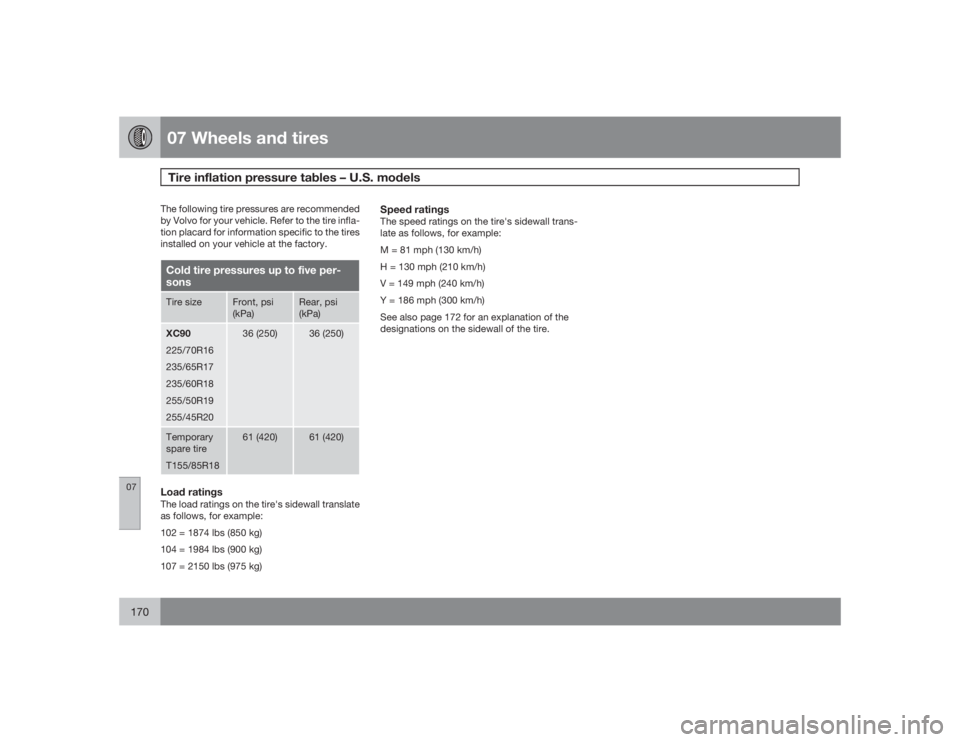
07 Wheels and tiresTire inflation pressure tables – U.S. models
07170
The following tire pressures are recommended
by Volvo for your vehicle. Refer to the tire infla-
tion placard for information specific to the tires
installed on your vehicle at the factory.Cold tire pressures up to five per-
sonsTire size
Front, psi
(kPa)
Rear, psi
(kPa)
XC90
225/70R16
235/65R17
235/60R18
255/50R19
255/45R20
36 (250)
36 (250)
Temporary
spare tire
T155/85R18
61 (420)
61 (420)
Load ratingsThe load ratings on the tire's sidewall translate
as follows, for example:
102 = 1874 lbs (850 kg)
104 = 1984 lbs (900 kg)
107 = 2150 lbs (975 kg)
Speed ratingsThe speed ratings on the tire's sidewall trans-
late as follows, for example:
M = 81 mph (130 km/h)
H = 130 mph (210 km/h)
V = 149 mph (240 km/h)
Y = 186 mph (300 km/h)
See also page 172 for an explanation of the
designations on the sidewall of the tire.
Page 171 of 282
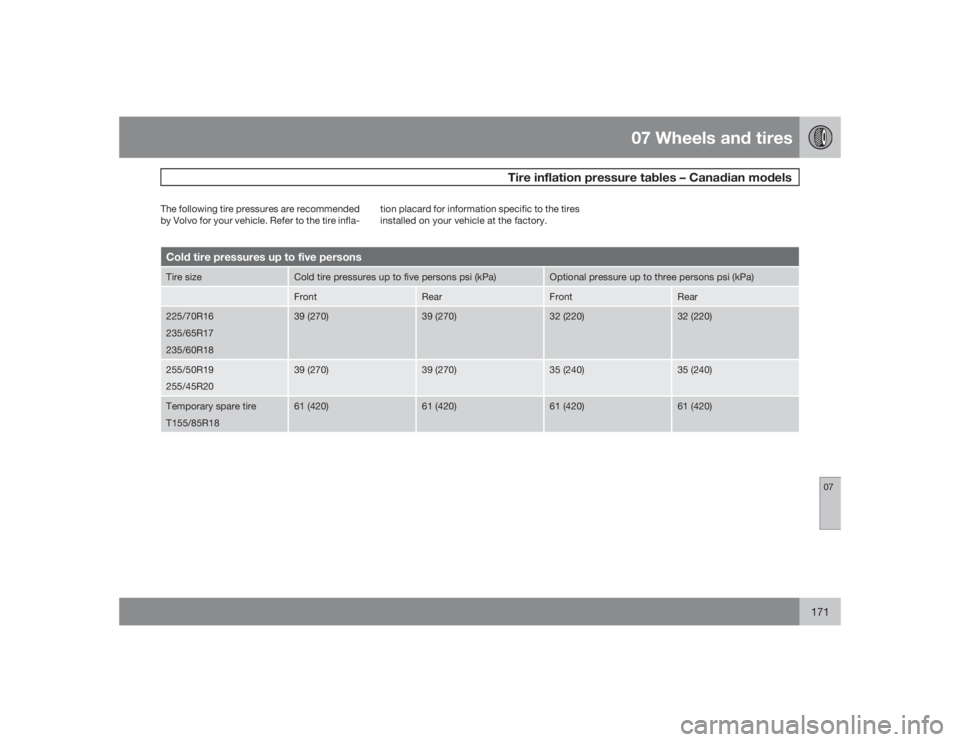
07 Wheels and tires
Tire inflation pressure tables – Canadian models
07
171
The following tire pressures are recommended
by Volvo for your vehicle. Refer to the tire infla-tion placard for information specific to the tires
installed on your vehicle at the factory.Cold tire pressures up to five personsTire size
Cold tire pressures up to five persons psi (kPa)
Optional pressure up to three persons psi (kPa)
Front
Rear
Front
Rear
225/70R16
235/65R17
235/60R18
39 (270)
39 (270)
32 (220)
32 (220)
255/50R19
255/45R20
39 (270)
39 (270)
35 (240)
35 (240)
Temporary spare tire
T155/85R18
61 (420)
61 (420)
61 (420)
61 (420)
Page 178 of 282
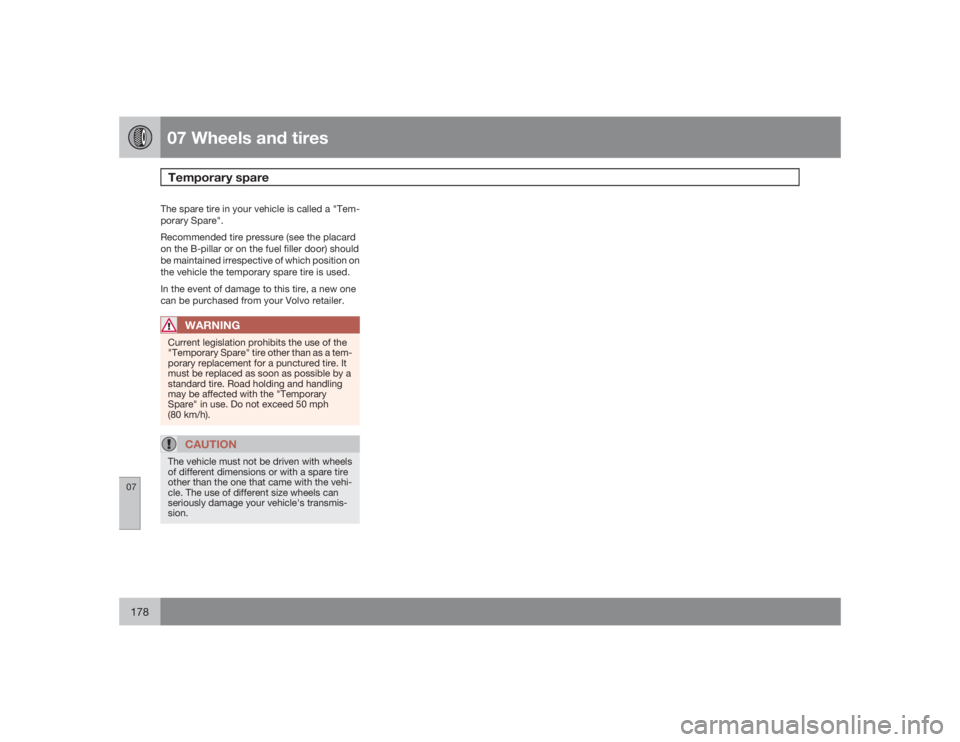
07 Wheels and tiresTemporary spare
07178
The spare tire in your vehicle is called a "Tem-
porary Spare".
Recommended tire pressure (see the placard
on the B-pillar or on the fuel filler door) should
be maintained irrespective of which position on
the vehicle the temporary spare tire is used.
In the event of damage to this tire, a new one
can be purchased from your Volvo retailer.
WARNING
Current legislation prohibits the use of the
"Temporary Spare" tire other than as a tem-
porary replacement for a punctured tire. It
must be replaced as soon as possible by a
standard tire. Road holding and handling
may be affected with the "Temporary
Spare" in use. Do not exceed 50 mph
(80 km/h).
CAUTION
The vehicle must not be driven with wheels
of different dimensions or with a spare tire
other than the one that came with the vehi-
cle. The use of different size wheels can
seriously damage your vehicle's transmis-
sion.